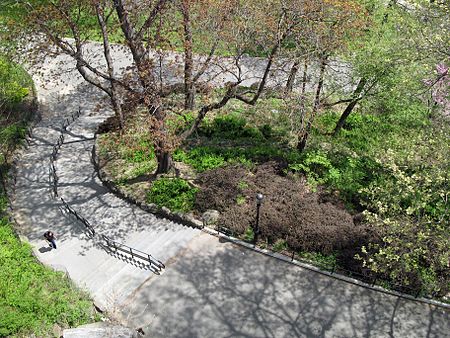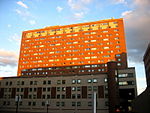Morningside Park (Manhattan)

Morningside Park is a 30-acre (12-hectare) public park in Upper Manhattan, New York City. The park is bounded by 110th Street to the south, 123rd Street to the north, Morningside Avenue to the east, and Morningside Drive to the west. A cliff made of Manhattan schist runs through the park and separates Morningside Heights, above the cliff to the west, from Harlem. The park includes other rock outcroppings; a man-made ornamental pond and waterfall; three sculptures; several athletic fields; playgrounds; and an arboretum. Morningside Park is operated by the New York City Department of Parks and Recreation, although the group Friends of Morningside Park helps maintain it. The area near Morningside Park was originally known as Muscota by the Lenape Native Americans in the Delaware languages. A park in this location was first proposed by the Central Park commissioners in 1867, and the city commissioned Central Park's designers Frederick Law Olmsted and Calvert Vaux to produce a design for the park in 1873. Jacob Wrey Mould was hired to design new plans in 1880, but little progress occurred until Olmsted and Vaux were asked to modify the plans following Mould's death in 1886. The Lafayette and Washington, Carl Schurz Monument, and Seligman Fountain sculptures were installed after the park was completed in 1895. After a period of neglect in the early 20th century, the park received sporting fields and playgrounds between the 1930s and the 1950s. Columbia University proposed constructing a gym in the southern end of the park in the early 1960s; the plan was abandoned after students organized protests against the gym in 1968, citing concerns over racial segregation. In the late 20th century, Morningside Park gained a reputation for high crime rates, and several groups devised plans to renovate the park. The site of the unbuilt Columbia gym was turned into a waterfall and pond in 1990, and the park's arboretum was added in 1998. The New York City Landmarks Preservation Commission designated Morningside Park as a city landmark in 2008.
Excerpt from the Wikipedia article Morningside Park (Manhattan) (License: CC BY-SA 3.0, Authors, Images).Morningside Park (Manhattan)
Giraffe Path, New York Manhattan
Geographical coordinates (GPS) Address Nearby Places Show on map
Geographical coordinates (GPS)
| Latitude | Longitude |
|---|---|
| N 40.8064897 ° | E -73.9581935 ° |
Address
Giraffe Path
Giraffe Path
10026 New York, Manhattan
New York, United States
Open on Google Maps

